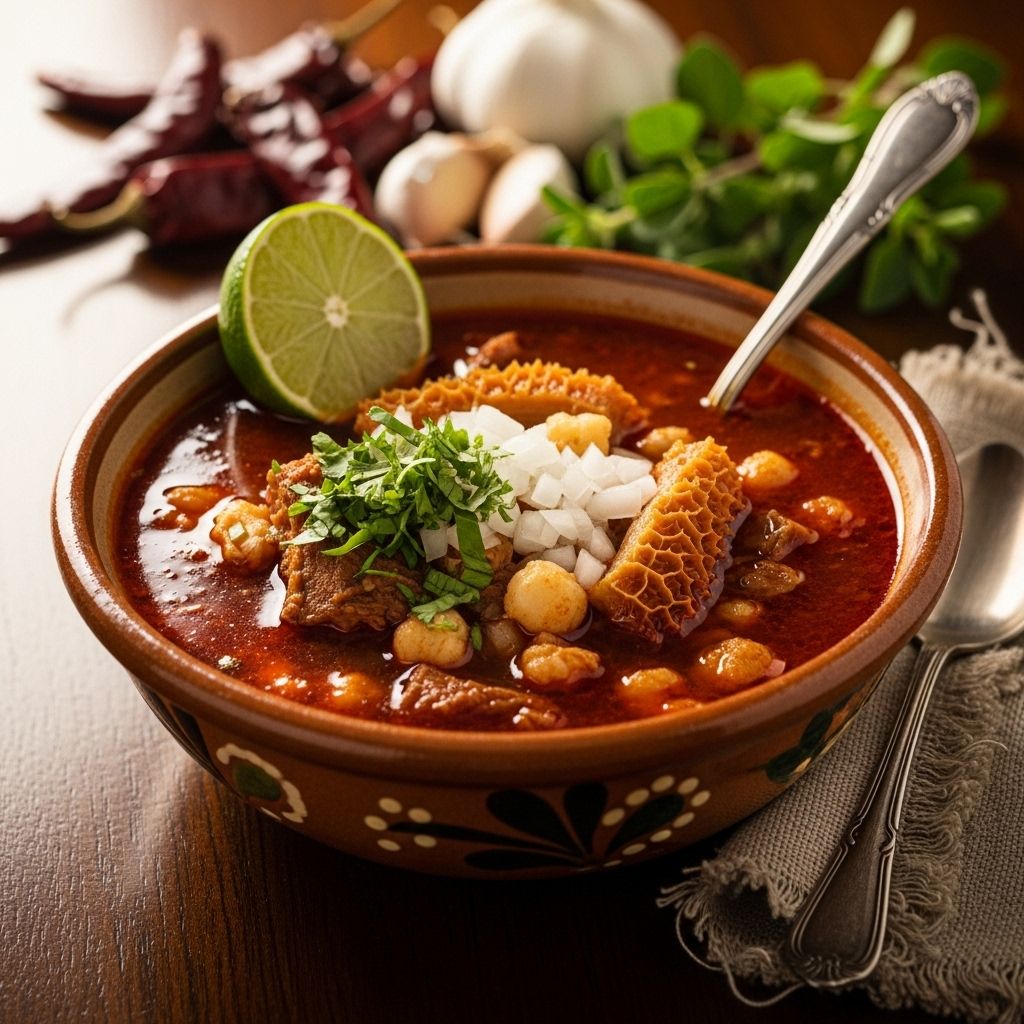Menudo Rojo: The Heart of Mexican Red Chile Tripe Soup
Slow-simmered tripe and hominy deliver a bold, savory broth that fuels communal feasts.

Menudo Rojo stands as one of Mexico’s most iconic and deeply beloved soups—a spicy, red chile-laced broth brimming with tender beef tripe, hominy, and an aromatic blend of seasonings. Passed down through generations, menudo isn’t just food—it’s a tradition as integral to Mexican culture as family gatherings and Sunday mornings. This article delves into every aspect of menudo rojo, offering historical context, expert preparation techniques, troubleshooting tips, and answers to frequently asked questions.
What Is Menudo Rojo?
Menudo Rojo, also known simply as Menudo, is a traditional Mexican soup crafted from beef tripe (the edible lining of a cow’s stomach), hominy (alkaline-treated maize kernels), and a broth infused with red chiles—most commonly guajillo, ancho, or a blend of Mexican dried chiles. Its vibrant red hue and bold flavor profile distinguish it from other Mexican soups, notably the green-hued Menudo Verde and white hominy soup known as Pozole.
- Main ingredients: Beef tripe, hominy, Mexican dried chiles, garlic, onion, oregano, cumin, and often beef feet or marrow bones for richness.
- Distinct features: Red chile broth, chewy yet tender tripe, hearty hominy, and aromatic garnishes.
- Occasions: Menudo is synonymous with celebrations, weekend breakfasts, and as a legendary remedy for hangovers across Mexican communities.
History and Cultural Significance
While the precise origins of menudo remain obscured by time, it is widely considered a product of Mexico’s resourceful culinary ingenuity. Dating back generations, menudo made use of less celebrated cuts—particularly tripe and beef feet—from the aftermath of communal slaughter. These ingredients, once regarded as humble or even undesirable, were transformed through slow cooking and bold seasoning into a soup both nourishing and deeply satisfying.
- Celebratory tradition: Menudo is frequently served at family gatherings, fiestas, and holidays—most notably on weekends and New Year’s morning as both communal feast and folkloric cure for excess revelry.
- Regional styles: While Menudo Rojo is predominant in northern and central Mexico, other regions favor green chile (Menudo Verde) or white versions.
- Symbol of hospitality: The time and care invested in menudo’s preparation reflect its role in Mexican life as a dish to be shared and savored together.
Step-by-Step Guide: How to Make Authentic Menudo Rojo
Crafting an exceptional Menudo Rojo is a labor of love requiring patience, care, and a focus on both technique and tradition. The process can span several hours, but the results are richly rewarding.
Essential Ingredients
- Beef tripe: Cleaned and cut into 1-2 inch pieces; honeycomb tripe is preferred for its texture and appearance.
- Hominy: Canned or freshly nixtamalized white corn kernels, drained and rinsed.
- Beef feet or marrow bones: Adds gelatin and depth to the broth.
- Guajillo, ancho, or other dried chiles: Destemmed, deseeded, and peeled.
- Garlic and onion: Used both in the simmering broth and the chile puree.
- Oregano and cumin: For earthy, herbal complexity.
- Salt and black pepper: Essential seasonings.
- Water: For simmering.
Preparation Overview
- Pre-cooking the tripe: Begin by rinsing the tripe thoroughly and simmering briefly in salted water to eliminate any impurities and mellow its aroma. Drain and rinse again.
- Creating the broth: In a large pot, combine tripe, beef feet/marrow bones, onion, garlic, salt, oregano, and water. Bring to a boil, reduce heat, and simmer gently for 2–3 hours, skimming any foam. The goal is meltingly tender tripe and a rich, slightly gelatinous broth.
- Preparing the chile puree: Toast dried chiles in a dry skillet until just fragrant—this deepens flavor. Soak chiles in hot water for 20–30 minutes. Blend the softened chiles with onion, garlic, cumin, and a ladleful of broth until smooth. Pass through a fine sieve to remove skins and seeds for a silky texture.
- Combining and simmering: Add the chile puree and hominy to the pot. Simmer for another 1–2 hours, adjusting seasoning as needed. The flavors will deepen and meld; the broth takes on its distinctive red hue.
- Final tasting and serving: Confirm tripe’s tenderness and balance of flavor. Adjust salt and check for spice. Menudo should be intensely savory, with subtle heat and deep chile tones.
Garnishes and Serving Traditions
- Lime wedges: Bring brightness and acidity to each bowl.
- Diced onion: Adds fresh crunch.
- Chopped cilantro: A herby flourish.
- Dried Mexican oregano: Sprinkled on top for aroma.
- Sliced radishes: A crisp, peppery bite.
- Warm corn tortillas: Essential for dipping and scooping.
- Cayenne or chile flakes (optional): For extra heat.
Techniques: Tripe, Hominy, and Red Chile
A few tips and best practices ensure the best possible Menudo Rojo:
- Tripe preparation: Even store-bought tripe benefits from a thorough rinse, brief pre-boil, and trimming. Honeycomb tripe is ideal for texture and appearance.
- Hominy choice: Canned hominy offers convenience, but freshly prepared nixtamalized maize will result in superior texture and flavor.
- Chile handling: Toasting intensifies flavor; soaking softens skins. Always strain the blended puree for a smooth, vibrant broth.
- Slow cooking: Tripe must be cooked for several hours to achieve tender, springy texture. Rushing this step sacrifices both flavor and mouthfeel.
Troubleshooting and Common Mistakes
- Tough or rubbery tripe: Results from insufficient cooking time. Always simmer low and slow, allowing gelatin and connective tissue to break down.
- Bland broth: Typically caused by under-seasoning or skipping bones/beef feet. Increase salt and incorporate more aromatic garnish.
- Greasy broth: Skim fat periodically, particularly if using bones or feet. A slight sheen is natural; excess can be removed before serving.
- Overly spicy or bitter: Taste chile puree before adding; some chiles (particularly anchos or pasillas) can turn bitter if burned or old.
Menudo Rojo versus Other Mexican Soups
| Soup | Main Protein/Cut | Broth Color | Signature Ingredients | Occasion |
|---|---|---|---|---|
| Menudo Rojo | Beef tripe | Red | Red chile, hominy, beef feet | Breakfast, celebrations, hangover cure |
| Pozole | Pork or chicken | Red, white, or green | Hominy, dried chiles | Festivals, family gatherings |
| Menudo Verde | Beef tripe | Green | Green chiles, herbs | Weekend meals, birthdays |
Expert Tips for Preparing Menudo Rojo at Home
- Patience pays: Allow ample time for tripe to tenderize and flavors to meld. The soup can be made a day ahead—flavors improve overnight.
- Balance broth and tripe: Use enough liquid to submerge tripe and bones, but not so much that flavors are diluted. Reduce slightly for concentration.
- Personalize garnishes: Let guests customize bowls with their favorite toppings: lime, onion, cilantro, and tortillas.
- Serve piping hot: Menudo should be near boiling when served; cold or lukewarm soup loses its texture and aromatic draw.
Menudo in Celebrations and Family Traditions
Menudo’s reputation as the dish of celebration permeates Mexican households. Its association with weekends, holidays, and communal feasts is legendary:
- Early breakfasts: Menudo is often served as a morning meal after late-night parties or festivities—a ritual believed to revive and fortify.
- Wedding and holiday feasts: Large batches feed crowds; the labor-intensive process turns into a social event itself.
- Sunday family gatherings: The preparation and eating of menudo invite storytelling, laughter, and connection.
Frequently Asked Questions (FAQs)
Q: Is menudo difficult to make at home?
A: Menudo requires patience, long slow cooking, and attention to ingredient quality. While technique matters, success is mostly about time and a willingness to taste and adjust as you cook.
Q: How do I remove the smell from tripe?
A: Rinse tripe thoroughly, boil briefly with salt, and rinse again. Adding aromatics (onion, garlic) during cooking further mellows its odor.
Q: Can menudo be made ahead and reheated?
A: Yes. In fact, menudo improves with time as flavors meld. Cool promptly, refrigerate, and reheat gently until steaming.
Q: What are some common garnishes for menudo?
- Fresh lime wedges
- Diced onion
- Chopped cilantro
- Sliced radishes
- Warm corn tortillas
Q: Why is menudo considered a hangover cure?
A: Menudo’s rich broth, protein-heavy ingredients, and spicy, acidic garnishes are traditionally believed to revive body and spirit after excess—making it a beloved comfort food after celebrations.
Conclusion: The Timeless Allure of Menudo Rojo
Menudo Rojo is much more than a soup; it is an emblem of Mexican culinary history, a showcase for transforming humble ingredients into soul-warming fare, and a dish that unites families across generations. Whether you prepare it for a special occasion or simply to savor the deep, vibrant flavors, Menudo Rojo remains a testament to the heart and tradition of Mexican cuisine—a soup both ancient and enduring, spicy and comforting, celebrated wherever Mexicans gather around the table.
References
Read full bio of Shinta












